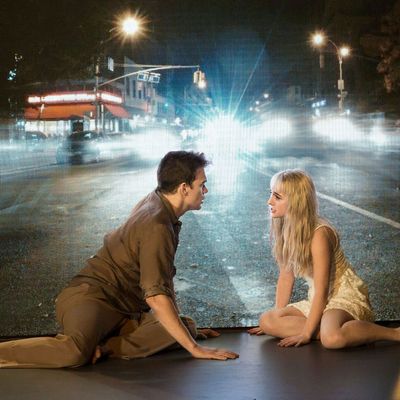
Here’s a sampling of things you’ll experience at Lazarus, the illustrated concept album disguised as a musical now playing at New York Theatre Workshop: one alien, two serial killers, three women in blue wigs, four in kimonos, a top-notch band of seven, 18 songs by David Bowie, and a fridge full of gin. I think you can infer the rest from there.
Not that you have to. So much imaginative horsepower has gone into the project that your contribution (and too often, it seems, your presence) is hardly wanted. There are, to begin with, those 18 Bowie songs, four of them new, the rest spanning the years from 1970 (“The Man Who Sold the World”) to 2013. They include some of his most famous (including “Changes,” “Life on Mars?” and “‘Heroes’,” and surely his least famous, too: the two-chord title song, scheduled to be released as part of his 25th studio album, on his 69th birthday, in January. As always, Bowie creates his effects out of the tension between personal, impenetrable lyrics and approachable, generic tune stylings sampled from everywhere: cocktail lounges, music halls, dance clubs, Abbey Road. If the results still keep listeners at a deliberate remove, they mostly remain a pleasure to listen to, especially as sung unusually well by, among others, Michael C. Hall, sounding like a Bowie double.
Hall plays Thomas Newton, a name you may recall from Nicolas Roeg’s 1976 movie The Man Who Fell to Earth, in which Bowie starred as an alien using that alias. If you do recall it, that’s more than Bowie does; he has admitted to being so coked-up during the shoot that he didn’t know what he was doing. The Man Who Fell to Earth is the kind of movie perhaps best experienced in that way: a dreamy, confusing sci-fi weepie about, literally, alienation. Based on a novel by Walter Tevis, it concerns Newton’s attempt to bring water from Earth to his home planet, which is dying (along with his family there) after a nuclear catastrophe. Failing in that effort, he also fails in human love, and ends up a prisoner in limbo between lives. If ever there was a character unlikely to anchor a musical, he is it, and yet Lazarus, as the name implies, resurrects him and his story to explore what happened next. The answer provided by the Irish playwright Enda Walsh, whose book for the musical Once helped make that show a hit, is “not much.” At the start of Lazarus, Newton is still stuck in the gap, in a perma-drunk stupor. Nor does he move from it during the course of the play’s action; rather, he encounters figures from his past and from his imagination, some apparently sent to help him move on, like spectral life coaches escaped from an episode of Oprah in Space. They fail.
Let us not dwell on the story, which even with Cristin Milioti as a psychotic assistant and Michael Esper as a psychotic interloper remains tertiary at best. Vying for top dog here are the music and the visuals, the latter organized by the director Ivo van Hove working with his regular designers. As if confusing the theater for an art museum (or MTV), they amaze the eye with bursts of color and busyness, life-or-illusion conundrums, and self-consciously pregnant imagery. Some of the gimmicks are wonderfully clever: a massacre is suggested with black balloons; a rocket ship is built onstage. The problem, for theatergoers looking for characters and narrative and the other useful trappings of drama, is that with all the visual and aural information, there is almost no room for any other kind. We get tics instead of personality, symbols instead of story, and, with few exceptions, dialogue that is spectacularly uninformative. The imbalance feels deliberately off-putting, willfully hermetic, resulting in a show that’s a laborious sit at two intermission-less hours. But it would be much the same at two minutes: Lazarus leaps straight to torpid and mystifying without first passing through curious and promising. When, in a pre-recorded video segment near the end, a surprise guest star tells another character that she isn’t “properly dead,” I knew just what he meant.
Lazarus is at New York Theatre Workshop through January 20.

